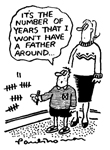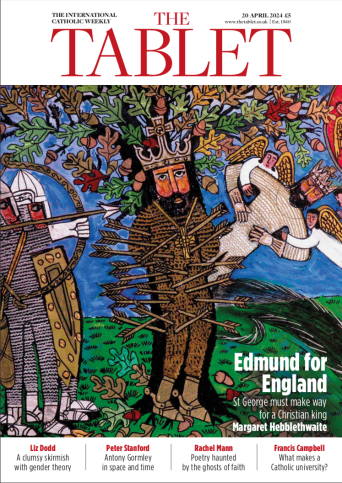Following last week’s article by theologian Karen Kilby, we continue the discussion sparked by Pope Francis’ call for a new theology of women. Here, a philosophical theologian urges all should be heard, especially the poorest
Few who have read Antonia White’s classic novel Frost in May, published in 1933 but set several decades earlier, will forget her droll account of a young girl’s education at the Convent of the Five Wounds, nor the notes the young girl made on the annual retreat given by a Jesuit:
Bad books do untold harm … Abominable works exposed in Mayfair drawing rooms. Zola, Anatole France, etc. Scientific works unsuitable for women. Puff up their vanity with idea they only half understand … Pity looking-glasses were ever invented. Think how ugly you are when you look in them. Imagine age, decay, etc … Women’s votes unnecessary. Let her use her great influence in her own sphere … Our Lady had no vote and did not want one.
These views, apart from the reference to Mary, were not restricted to Catholics in the Edwardian period. Forward-looking politicians and enlightened members of the public (women as well as men) believed that women were constitutionally unsuited to higher education or the professions, that giving a woman the vote would simply mean giving her husband (or in default of such, her father) two votes. As Virginia Woolf noted at the time, there was no shortage of books by men about what women were, or are and should be.
Whatever Pope Francis intends in saying we need “a theology of women”, he does not mean simply more theology written by men about women. By all means, continue. But let’s listen to the women.
It will not do to say that since men and women are equal in Christ, we don’t need women theologians since men alone suffice for the task. As to what difference this theology of women will make, we should admit we don’t know. It’s of the nature of something new that we cannot say what results will come, but that we will be, and already are, in receipt of fresh understanding from women theologians is evident.
This is less to do with biological difference and more with social practice, such as who cares for the elderly or makes the meals. These patterns differ through place and time – most of Africa’s farmers are women, and in ancient Egypt men did the weaving – yet in all cultures, we know simply being a woman or a man (whether here or in Nigeria or Pakistan) means you are perceived by and received into the world differently.
Although the differences between the way men and women look at things are, for the most part, not based in biology, I can think of a few that might be. One of my male professorial colleagues, searching for a “universal human experience”, hit upon this: “For all of us, our skin is the outside of our body.” “Not”, I thought, “when you are pregnant.” At that time, the inside of your body is the outside of someone else’s. And why shouldn’t the fact that human beings all begin inside the body of another – so that one person’s insides are, for the period of gestation, another’s outsides – be of philosophical moment and even affect Christian anthropology? Philosophers haven’t considered such matters because they have, for the most part, been men. How many major philosophers have written on childhood? Considering this with a woman philosopher friend, we came up with Montaigne, who pondered how difficult it was to tell his son he loved him, and Augustine, who drew conclusions on philosophy of language from his son, Adeodatus.
This one-sidedness is not simply because philosophers (and theologians) have been men, but because they’ve been men of a certain world, whether by birth or elevation, insulated from the day-to-day palaver of family kitchens, nappies changed and clothes washed. The feminist political philosopher Alison Jaggar has observed that if Hobbes had given consideration to how much cooperation is required for a baby to survive its first year, he could never have asserted that human existence is “the war of all against all”.
Whatever changes may be in store for the Church, I hope we will see suitably qualified women and lay men preach, even if not the homily at Mass. How many sermons have I heard about the woman with the haemorrhage and not one mentioning the nature or source of her incessant bleeding. It was not a nosebleed. But it is important to the story, for not only had her vaginal bleeding meant she had been ritually unclean for many years, and thus isolated from many activities, even in her own home, but she was a fortiori infertile, cut off from all the sources of life.
That Jesus should not recoil from being approached by this defiling woman – and indeed by the touch of his garment and her faith heal her – is a sign that his own shaming execution in the near future was not defilement but the gateway to life. It is with reason that the ancient Church conflated the woman with the haemorrhage with Veronica – she who wiped blood from the face of Christ with her veil.
Whether we see it or not, we are all feminists today, if in varying degrees. Notions deeply offensive to right-minded people 100 years ago are common sense now. Only 20 years ago, I consoled a history student who had come across an archive of medieval Spanish wills where widows left their money to the Poor Clares, much to the consternation of their families. She was told by her supervisor that she would never get a Cambridge doctorate on that kind of feminist rubbish.
Ten years later, after the brilliant explorations of historian Caroline Walker Bynum, medieval nuns and women mystics were all the rage. Dr Susan O’Brien, whose research is on women Religious in Britain in the nineteenth century, until recently found herself having to persuade sister librarians not to get rid of their archives because they thought no one would be interested in them. In several English cities, these women Religious were pioneers of working with the very poor, and with women. Women doing theology – as New Testament scholars, historians, liturgists or canon lawyers – will see different things, not just because they are formally feminists (they may or may not be).
During my time as a visiting professor at Rome’s Gregorian University, I became aware that it was possible to inhabit the iconography of Catholicism, especially in Rome and from the seventeenth century onwards, as though women did not exist. Serried ranks of portraits of cardinal princes gave no sense of who starched the collars or made the lace or washed the underwear of these lordly beings.
By contrast with the British Museum’s recent Pompeii and Herculaneum exhibition, where Roman women appeared as powerful benefactresses, scribes and business women, in the eighteenth and nineteenth centuries, in Catholic renditions women were depicted as cloying and servile throughout. This was even so of the Virgin who, in early Byzantine representations is usually a powerful orantes figure.
It is still globally the case – and Pope Francis is well aware – that the poorest of the poor, the last on the list for food, medicine and education, are women. We need to listen to them, and give them the training to speak the language of Church and academy.
The patron saint for “listening to women” must surely be St Peter. How grateful we should be that, on his way to discipleship, he got so much wrong – attempting to correct Jesus for his gloomy prognostications (“Get behind me, Satan”), misjudging the significance of the Transfiguration (“Let us build three booths”), and, most humbling of all, denying Christ three times before the cock crowed.
St Peter, following the party that arrested Jesus to the courtyard of the High Priest, was no doubt prepared to testify for Jesus even to the point of death – and not least because Jesus had predicted, only that evening, that Peter would deny him. But in the event, it was neither the High Priest nor the captain of the guard who challenged him, but a servant girl: “You also were with Jesus the Galilean.” And, according to Matthew, it was a second servant girl who said, “This man was with Jesus.”
To what does the testimony of servant girls amount? But Peter was, by now, trapped in his denials, and with his final “I do not know the man”, the cock crowed. If only he had listened to the women. His successor has that opportunity now.





 Loading ...
Loading ...
What do you think?
You can post as a subscriber user...
User Comments (0)